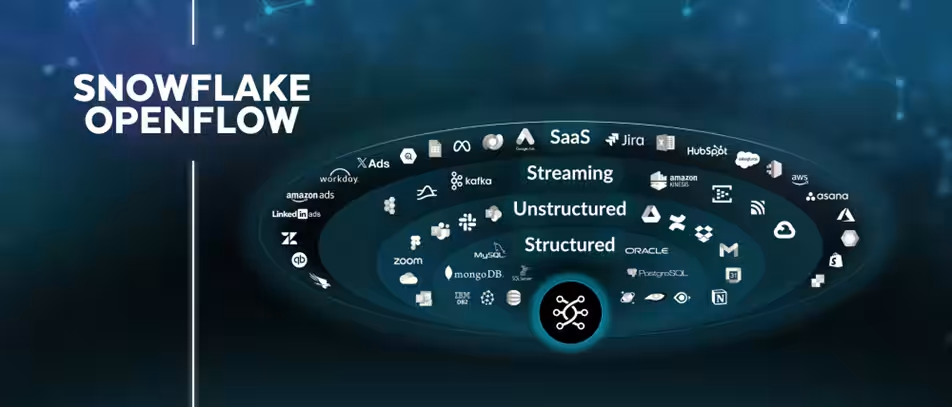

Unlocking Seamless Data Movement: Snowflake Openflow's Revolutionary Integration for AI Innovation
Transforming Data Movement with Snowflake Openflow
Snowflake, a prominent player in the AI data cloud sector, has recently introduced its innovative solution, Snowflake Openflow, at the annual Snowflake Summit 2025. This revolutionary service aims to redefine how data is moved across various platforms while ensuring complete interoperability, ultimately accelerating AI innovation.
Openflow incorporates Apache NiFi™, a project by the Apache Software Foundation, facilitating an open and extensible environment for managed data movement. This integration not only simplifies the data transfer process from its source to its utilization point but also positions Snowflake as a leader in intelligent data solutions that connect disparate data ecosystems.
What is Snowflake Openflow?
Designed to meet the needs of modern organizations, Openflow serves as a multimodal data ingestion service. It enables users to connect with virtually any data source seamlessly, unlocking value from a wide array of data architectures. Through a network of pre-built, extensible connectors, thousands of global customers can link their enterprise data ecosystems with AI models, applications, and data agents directly on the Snowflake platform.
Chris Child, Vice President of Product and Data Engineering at Snowflake, emphasized that Openflow significantly streamlines data accessibility and AI readiness. He pointed out that many of their clients have adopted AI-first data strategies, seeking swift access to all types of data from a single platform. The new model also introduces a Bring Your Own Cloud capability, which is currently available generally on AWS.
Addressing Data Challenges in AI
As we step into an era dominated by artificial intelligence, companies require a robust and clean data environment to leverage AI effectively. Data engineers often grapple with inflexible data pipelines and fragmented data stacks, hindering their ability to adapt to the necessary scales and response times demanded in today's AI landscape. Traditional data integration methods have proved inadequate for the dynamic, multidimensional data needs of AI.
Snowflake Openflow enters into a $15 billion market segment, offering an open and extensible managed multimodal data integration service. This allows for the integration of structured, unstructured, batch, and streaming data, smoothing the transition from data generation to its application. Such capabilities lay the groundwork for streamlined ETL processes essential for AI development.
Several partner organizations, including FactSet’s subsidiary Irwin, Securonix, and WorkWave, have begun leveraging Openflow’s features to expand their secure data integration efforts without compromising operational simplicity or governance.
Key Innovations and Features
1. Enhanced Data Engineering: Openflow supports new data engineering practices, integrating seamlessly into existing Snowflake workflows. This addition will facilitate features like improved support for Apache Iceberg™ tables and fast streaming data processing through Snowpipe Streaming.
- The new architecture will allow data ingestion speeds of up to 10GB per second, drastically reducing the time between data capture and query readiness to just 5 to 10 seconds.
2. Pre-built Connectors and Processors: Snowflake has equipped Openflow with hundreds of immediately available connectors and processors, ensuring quick and secure data integration across a variety of platforms, including Box, Google Ads, Microsoft Dataverse, and more. This extensive compatibility promotes a more cohesive environment for AI-driven strategies.
3. Simplified Pipeline Management: In conjunction with Openflow, Snowflake is enhancing its dbt (data build tool) projects, combining automation and managed services with open-source data transformation workflows. This will empower users to focus on generating insights rather than maintaining infrastructure, enhancing operational efficiency.
4. Unified Data Lakehouse Management: Snowflake Openflow supports connecting various data technologies and offers a consolidated view of an open lakehouse, improving both governance and security while ensuring extensive access to data insights.
5. Partnerships Driving Integration: Significant partnerships with industry leaders like Adobe and Microsoft underline the power of Openflow. Their collaborative efforts aim to empower clients by unlocking new value through advanced customer insights and ensuring seamless data movement across platforms.
Conclusion
As businesses navigate the complexities of data management and strive for AI advancements, Snowflake Openflow presents a timely and impactful solution. By eliminating fragmented data stacks and manual processes, Snowflake is positioning itself as a beacon of innovation in the world of data movement. Companies looking to enhance their AI capabilities can leverage Openflow to streamline data integration, optimize workflows, and ultimately drive success in today's data-driven landscape.
For more insights on Snowflake's advancements and how you can optimize your data strategy, check out our latest developments on social media using #SnowflakeSummit.

Topics Consumer Technology)










【About Using Articles】
You can freely use the title and article content by linking to the page where the article is posted.
※ Images cannot be used.
【About Links】
Links are free to use.